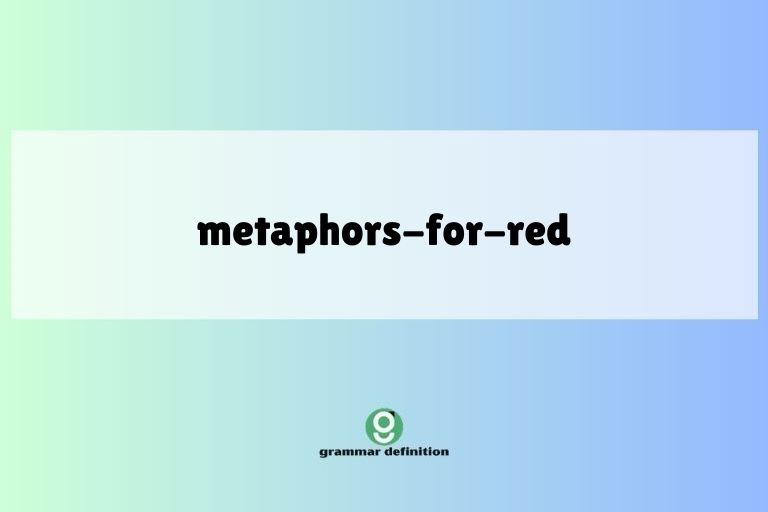Home as a Metaphor: Exploring Figurative Language

Understanding metaphors is crucial for mastering English, enhancing both comprehension and expression. Metaphors allow us to connect seemingly unrelated concepts, adding depth and color to our language.
This article delves into the specific use of “home” as a metaphor, exploring its various meanings and applications in everyday speech and literature. This comprehensive guide is designed for English language learners of all levels, from beginners seeking to expand their vocabulary to advanced speakers aiming to refine their understanding of figurative language.
By exploring the different ways home can be used metaphorically, you’ll gain a deeper appreciation for the nuances of English and improve your ability to communicate effectively. Whether you’re preparing for an exam, writing a creative piece, or simply seeking to enhance your language skills, this article provides the knowledge and practice you need to succeed.
Table of Contents
- Introduction
- Definition of Home as a Metaphor
- Structural Breakdown of Home Metaphors
- Types and Categories of Home Metaphors
- Examples of Home Metaphors
- Usage Rules for Home Metaphors
- Common Mistakes with Home Metaphors
- Practice Exercises
- Advanced Topics: Exploring Nuances
- Frequently Asked Questions
- Conclusion
Definition of Home as a Metaphor
A metaphor is a figure of speech that directly compares two unrelated things, suggesting a likeness between them. When “home” is used as a metaphor, it transcends its literal meaning of a physical dwelling and represents something else entirely. It evokes feelings, ideas, or concepts associated with the traditional idea of a home, such as comfort, safety, belonging, or origin. The metaphorical use of “home” taps into our deep-seated emotional connection to the place we consider our sanctuary.
The function of “home” as a metaphor is to enrich language by adding layers of meaning and emotional resonance. Instead of simply stating a feeling or concept, using “home” as a metaphor allows us to convey complex emotions and ideas in a more vivid and relatable way. It allows the speaker to evoke feelings of safety, security, love, nostalgia, or longing in the listener’s mind. Home metaphors are classified as conceptual metaphors, meaning that the abstract concept of “home” is used to understand and express other abstract concepts.
The contexts in which “home” can be used metaphorically are incredibly diverse. It can appear in literature, poetry, song lyrics, everyday conversations, and even business settings.
For example, a company might describe itself as a “home” for innovation, implying a supportive and nurturing environment. A person might say that a particular activity or hobby “feels like home” to them, suggesting that it brings them comfort and joy.
The versatility of “home” as a metaphor makes it a powerful tool for communication and expression.
Structural Breakdown of Home Metaphors
The structure of a home metaphor typically involves two key elements: the tenor and the vehicle. The tenor is the subject being described, and the vehicle is the metaphorical term used to describe it. In the case of home metaphors, “home” is usually the vehicle, while the tenor can be a wide range of abstract concepts or feelings. The connection between the tenor and vehicle is established through shared characteristics or associations.
Consider the sentence, “Her heart was his home.” Here, the tenor is “her heart,” and the vehicle is “home.” The metaphor suggests that her heart provides him with the same sense of comfort, security, and belonging that a physical home would provide. The shared characteristics that link the tenor and vehicle are feelings of safety, love, and acceptance.
This connection relies on the listener’s understanding of what “home” typically represents.
Another structural element to consider is the ground of the metaphor, which refers to the shared characteristics that make the comparison meaningful. Identifying the ground helps to clarify the intended meaning of the metaphor. For example, in the phrase “This library is my home,” the ground might be the feelings of comfort, intellectual stimulation, and a sense of community that the speaker associates with both the library and their idea of home. Understanding the ground is essential for interpreting metaphors accurately.
Metaphorical structures can also be extended, creating more complex and nuanced meanings. An extended metaphor develops the comparison over several sentences or even an entire piece of writing.
This allows for a more detailed exploration of the relationship between the tenor and the vehicle, adding depth and complexity to the overall message. Consider a poem where the speaker describes their childhood as a “broken home,” elaborating on the specific ways in which it lacked the stability, security, and love that a traditional home should provide.
Types and Categories of Home Metaphors
Home metaphors are diverse and can be categorized based on the specific aspects of “home” that they emphasize. Understanding these categories can help you better interpret and use home metaphors in your own communication.
Home as a Place of Comfort and Security
This category emphasizes the physical and emotional safety that home provides. Metaphors in this category often associate “home” with feelings of warmth, relaxation, and protection from the outside world.
It’s a sanctuary from stress and a place to recharge.
Home as a Sense of Belonging and Identity
These metaphors focus on the social and emotional connections associated with home. “Home” represents a place where one feels accepted, loved, and understood.
It’s where one’s identity is nurtured and celebrated. This can extend beyond a physical location to encompass a community or group of people.
Home as a Symbol of Origin and Roots
This category emphasizes the connection between home and one’s past. “Home” represents one’s upbringing, cultural heritage, and personal history.
It evokes memories of childhood, family traditions, and formative experiences. It is intrinsically linked to where you come from, both geographically and culturally.
Home as a Goal or Destination
Here, “home” represents a future aspiration or a desired state of being. It symbolizes a goal that one is striving towards, a place where one hopes to find happiness and fulfillment.
This can be a literal future home or a metaphorical state of contentment.
Home as a State of Mind
This category transcends the physical location entirely. “Home” represents an internal state of peace, contentment, and self-acceptance.
It’s a feeling of being grounded and centered, regardless of one’s physical surroundings. This is often linked to meditation, mindfulness, or finding inner peace.
Examples of Home Metaphors
To illustrate the different types of home metaphors, here are several examples categorized for clarity. Each table provides a variety of sentences using “home” metaphorically, showcasing the diverse ways this concept can be applied.
The following table presents examples of “Home as Comfort and Security.” These metaphors emphasize the protective and relaxing aspects of home.
| Example Sentence | Explanation |
|---|---|
| His music was her home after a long day. | Music provided her with relaxation and comfort, like a home. |
| For the weary traveler, the inn was a temporary home. | The inn offered a safe and comfortable place to rest. |
| Her grandmother’s arms were always a home to her. | Her grandmother’s embrace provided a feeling of safety and love. |
| The library became his home, a refuge from the world. | The library offered him a safe and comforting escape. |
| Yoga is my home; it centers and calms me. | Yoga provides a sense of inner peace and stability. |
| A warm bath is my home after a stressful day at work. | The bath provides comfort and relaxation, like a home. |
| That old armchair was his home; he spent hours reading there. | The armchair was his favorite place to relax and unwind. |
| The forest was a home to the animals, providing shelter and food. | The forest offered a safe and nurturing environment for the animals. |
| Her faith was her home, a source of strength and comfort. | Her faith provided her with a sense of security and peace. |
| The old bookstore was a home for book lovers. | The bookstore provided a comfortable and welcoming environment for readers. |
| His memories were his home, filled with warmth and nostalgia. | His memories provided him with comfort and a sense of connection to the past. |
| The quiet cafe was her home, a place to escape and think. | The cafe offered her a peaceful and relaxing environment. |
| The beach was my home during those summer months. | The beach provided a sense of relaxation and escape. |
| For many years, the theater was my home. | The theater provided a sense of comfort, belonging, and purpose. |
| After the storm, the community center became a home for many. | The community center offered shelter and support to those in need. |
| Her garden was her home, a place of peace and beauty. | The garden provided her with a sense of tranquility and connection to nature. |
| The old church was a home for the faithful. | The church offered a place of worship and spiritual comfort. |
| His art was his home, a way to express himself and find solace. | Art provided him with a means of self-expression and emotional release. |
| The mountain cabin was their home away from home. | The cabin provided a comfortable and relaxing escape from their everyday lives. |
| The shelter provides a temporary home for those in need. | The shelter offers a safe place and resources to those struggling with homelessness. |
The following table focuses on “Home as Belonging and Identity.” These metaphors emphasize the connection to a group or place where one feels accepted.
| Example Sentence | Explanation |
|---|---|
| The team was his home; he felt accepted and valued. | The team provided him with a sense of belonging and purpose. |
| This community is my home; I feel like I truly belong here. | The community offers a sense of acceptance and connection. |
| Her friends were her home; they supported her through everything. | Her friends provided her with a sense of belonging and unconditional support. |
| The dance studio was her home; she felt alive and free there. | The dance studio provided her with a sense of passion and self-expression. |
| For the refugees, the camp became their temporary home. | The camp provided a sense of community and shared experience. |
| The internet became a home for those seeking connection. | The internet provides platforms for people to connect and form communities. |
| The support group was her home; she found understanding and empathy. | The support group provided her with a safe space to share her experiences. |
| The university was his home for four years, shaping his identity. | The university provided him with a formative experience that shaped his personal and intellectual growth. |
| For nomadic tribes, their land is their home. | Their land is where their sense of identity and belonging comes from. |
| The theater troupe was her home; they were her family. | The theater troupe provided her with a sense of community and belonging. |
| This online forum is my home; I’ve found my niche here. | The forum provides a community of like-minded individuals. |
| The artist collective was his home; he found inspiration and collaboration. | The collective provided him with a supportive and stimulating environment. |
| His heart was her home; she felt completely accepted. | She felt loved and secure in the relationship. |
| The orphanage became a home for many children. | The orphanage provided a sense of family and belonging for children without parents. |
| The monastery was a home for those seeking spiritual enlightenment. | The monastery provided a place for contemplation and spiritual growth. |
| Our shared love of books makes this book club my home. | The book club is where I feel connected and understood. |
| The coding community is my home; I learn and grow with them. | The coding community is where I feel supported and inspired. |
| After years of searching, she finally found her home in the yoga studio. | The yoga studio is where she feels most at peace and connected to herself. |
| The writer’s group was his home; he found encouragement and feedback. | The writer’s group provided him with a supportive and constructive environment. |
| The LGBTQ+ center is a home for many in the community. | The center provides a safe and inclusive space for LGBTQ+ individuals. |
This table shows examples of “Home as Origin and Roots,” emphasizing the connection to one’s past and heritage.
| Example Sentence | Explanation |
|---|---|
| Her hometown will always be her home, no matter where she lives. | Her hometown represents her roots and upbringing. |
| For many immigrants, their homeland remains their true home. | Their homeland represents their cultural heritage and identity. |
| His family’s history was his home, a source of pride and identity. | His family’s history shaped his sense of self and belonging. |
| The old family farm was their home, passed down through generations. | The farm represented their family’s history and connection to the land. |
| The traditions of her ancestors were her home, guiding her life. | Her ancestors’ traditions provided her with a sense of continuity and identity. |
| Childhood memories are my home; they bring me back to simpler times. | Childhood memories provide a sense of nostalgia and connection to the past. |
| The old photograph album was her home, filled with faces and stories. | The album contained memories of her family and their history. |
| The language of her parents was her home, connecting her to her heritage. | Language served as a link to her cultural identity. |
| The stories told around the campfire were their home, preserving their culture. | Stories passed down through generations helped maintain their cultural heritage. |
| The recipes of her grandmother were her home, a taste of her past. | The recipes evoked memories of her grandmother and her family’s culinary traditions. |
| The music of her country was her home, expressing her identity. | Music served as a powerful connection to her cultural heritage. |
| The art of her ancestors was her home, inspiring her creativity. | Art provided her with a sense of connection to her cultural roots. |
| His roots are his home; they ground him and give him strength. | His origins provide him with stability and a sense of purpose. |
| She carries her culture as her home, wherever she goes. | Her cultural identity is an integral part of who she is. |
| The town square was their home, the heart of their community. | The town square represented the center of their social and cultural life. |
| He always found his way back home, drawn by his roots. | His connection to his origins was a powerful force in his life. |
| The old family Bible was their home, recording their history. | The Bible contained records of births, deaths, and marriages, preserving their family’s history. |
| They returned to their ancestral home, seeking to reconnect with their past. | They sought to understand their roots and cultural heritage. |
| The land was their home, providing them with sustenance and identity. | Their connection to the land was essential to their survival and cultural identity. |
| The museum was a home for their artifacts, preserving their history. | The museum served as a repository of their cultural heritage. |
Here are examples of “Home as a Goal or Destination,” emphasizing future aspirations and desired states of being.
| Example Sentence | Explanation |
|---|---|
| Retirement is her home; she dreams of relaxing and traveling. | Retirement represents her future goal of leisure and freedom. |
| Success is his home; he’s working tirelessly to achieve it. | Success represents his ultimate goal and destination. |
| Happiness is her home; she’s constantly seeking it. | Happiness represents her desired state of being. |
| Financial stability is his home; he’s saving diligently. | Financial stability represents his goal of security and peace of mind. |
| Inner peace is her home; she meditates daily to find it. | Inner peace represents her desired state of tranquility and self-acceptance. |
| Finding love is her home; she’s open to new relationships. | Finding love represents her goal of companionship and emotional fulfillment. |
| Creating art is his home; he aspires to be a renowned artist. | Art represents his passion and his ultimate career goal. |
| Achieving enlightenment is her home; she practices mindfulness. | Enlightenment represents her spiritual goal and desired state of being. |
| Making a difference is his home; he volunteers regularly. | Making a difference represents his goal of contributing to society. |
| Building a family is her home; she dreams of having children. | Building a family represents her desired future. |
| Completing her education is his home; he is determined to graduate. | Completing her education is a goal and a symbol of stability. |
| A world without poverty is their home; they dedicate their lives to activism. | A world without poverty is their shared vision and driving force. |
| His dream house is his home; he saves every penny towards it. | His dream house is his goal, a tangible representation of his aspirations. |
| Becoming a doctor is her home; she is committed to helping others. | Her career aspiration is seen as a destination where she can fulfill her purpose. |
| For the entrepreneur, success is their home; they are constantly innovating. | The entrepreneur’s drive for success is a continuous journey. |
| A sustainable future is our home; we must work together to achieve it. | A sustainable future is a collective goal, a shared responsibility. |
| Reaching self-actualization is his home; he is on a journey of discovery. | Self-actualization is a state of fulfillment that he seeks. |
| A peaceful world is their home; they advocate for diplomacy and understanding. | A peaceful world is a shared vision that inspires their activism. |
| For the athlete, the championship is their home; they train relentlessly. | The championship is the ultimate achievement, the pinnacle of their efforts. |
| A cure for cancer is their home; scientists are working tirelessly to find it. | Finding a cure is a shared goal that drives medical research. |
Lastly, this table presents examples of “Home as a State of Mind,” emphasizing inner peace and self-acceptance.
| Example Sentence | Explanation |
|---|---|
| Peace of mind is her home; she cultivates it through meditation. | Peace of mind represents her internal state of tranquility. |
| Self-acceptance is his home; he embraces his flaws and strengths. | Self-acceptance represents his internal state of contentment. |
| Mindfulness is her home; she lives in the present moment. | Mindfulness represents her internal state of awareness. |
| Contentment is his home; he appreciates what he has. | Contentment represents his internal state of satisfaction. |
| Resilience is her home; she bounces back from adversity. | Resilience represents her internal strength and ability to cope. |
| Gratitude is his home; he focuses on the positive aspects of life. | Gratitude represents his internal state of appreciation. |
| Compassion is her home; she empathizes with others. | Compassion represents her internal state of empathy and kindness. |
| Inner strength is his home; he relies on his own resources. | Inner strength represents his internal resilience and self-reliance. |
| Forgiveness is her home; she lets go of resentment. | Forgiveness represents her internal state of peace and release. |
| Authenticity is his home; he lives true to himself. | Authenticity represents his internal state of self-awareness and honesty. |
| Joy is her home; she finds happiness in simple things. | Joy is a state of mind and a perspective that she cultivates. |
| Serenity is his home; he remains calm in stressful situations. | Serenity represents his ability to maintain inner peace. |
| Home is where the heart is, a state of mind, not a place. | Home is defined by feelings of love, belonging, and peace within oneself. |
| She found her home within herself, a sense of inner peace. | She discovered a feeling of tranquility and self-acceptance. |
| His spirit was his home, resilient and unwavering. | His inner strength provided him with stability and purpose. |
| Home is the feeling of being grounded, no matter where you are. | The sense of stability and connection can be found anywhere. |
| Her soul was her home, a sanctuary of self-love. | She nurtured a space of self-acceptance and compassion. |
| He carried his home with him, a sense of inner peace and resilience. | His ability to find peace and strength within himself. |
| Home is the quiet space within, where you find yourself. | Home is a place of introspection and self-discovery. |
| Her heart was her home, filled with love and compassion for others. | Her capacity for love and empathy defined her internal state. |
Usage Rules for Home Metaphors
When using “home” as a metaphor, it’s important to ensure clarity and relevance. The connection between the tenor and the vehicle (home) should be easily understood by the audience.
Overly abstract or obscure comparisons can lead to confusion. The metaphor should enhance the meaning, not obscure it.
Always consider your audience and their understanding of the connotations of “home.”
Consistency is also crucial, especially when using extended metaphors. Maintain the connection to “home” throughout the passage or piece of writing to avoid confusing the reader. If you start by describing a company as a “home” for innovation, continue to use language and imagery that reinforces this idea. Don’t introduce conflicting metaphors that undermine the initial comparison.
Avoid clichés. While some home metaphors have become common phrases (e.g., “home is where the heart is”), overuse can diminish their impact. Try to find fresh and original ways to use “home” metaphorically. Consider the specific qualities of “home” that you want to emphasize and find creative ways to connect them to the tenor. Explore different aspects of home, such as its architecture, inhabitants, or emotional atmosphere, to create more unique and evocative metaphors.
Also, be mindful of cultural sensitivity. The concept of “home” can have different meanings and connotations in different cultures. Be aware of these differences and avoid using metaphors that might be offensive or inappropriate. Consider the cultural background of your audience and tailor your metaphors accordingly. For example, in some cultures, “home” might be strongly associated with family and tradition, while in others, it might be more closely linked to personal freedom and independence.
Common Mistakes with Home Metaphors
One common mistake is using metaphors that are too vague. For example, saying “Life is my home” is too broad and doesn’t convey a specific meaning. It lacks the necessary connection to create a clear picture. Instead, try to be more specific about what aspect of life you’re comparing to home. For instance, “My career is my home; it provides me with stability and purpose” is far more effective.
Another mistake is using mixed metaphors, which combine unrelated images and create confusion. For instance, “Her career was a home, sailing smoothly through rough waters” mixes the idea of a home with the image of sailing, creating a nonsensical comparison.
The metaphor becomes confusing and unclear. It’s important to maintain a consistent image throughout the metaphor.
Overusing metaphors can also diminish their impact. Too many metaphors can clutter your writing and make it difficult for the reader to follow your meaning.
Use metaphors sparingly and strategically, choosing the most effective ones to highlight key points. Remember that the goal of a metaphor is to enhance understanding, not to overwhelm the reader with imagery.
Here’s a table illustrating some common mistakes and their corrections:
| Incorrect | Correct | Explanation |
|---|---|---|
| Life is my home. | My garden is my home; it is where I find peace. | The original phrase is too vague. The corrected version specifies the aspect of “home” being emphasized (peace). |
| Her career was a home, sailing smoothly through rough waters. | Her career was a home, providing her with stability and comfort. | The original phrase mixes unrelated images (home and sailing). The corrected version maintains a consistent image of “home.” |
| The internet is a home, a highway, and a garden. | The internet is a home for connecting with others. | The original phrase uses too many metaphors at once. The corrected version focuses on a single, clear comparison. |
| His love was her home, flowing like a river. | His love was her home, a safe and comforting place. | Mixing the ideas of love as a home with the image of a flowing river. |
| The project was a home, but it quickly became a storm. | The project was a promising start, but it quickly became a disaster. | Changing the initial concept of the project being a home into a storm. |
Practice Exercises
Test your understanding of home metaphors with these exercises. Identify the type of home metaphor used in each sentence and explain its meaning.
These exercises help you practice identifying and interpreting home metaphors in different contexts. Pay attention to the specific connotations of “home” that are being emphasized in each sentence.
Exercise 1: Identify the type of home metaphor used in each sentence (Comfort, Belonging, Origin, Future, State of Mind).
| Question | Answer |
|---|---|
| 1. Her faith was her home; it gave her strength. | Comfort |
| 2. The community center became a home for the displaced. | Belonging |
| 3. Their traditions were their home, connecting them to their ancestors. | Origin |
| 4. A world without war is their home; they strive for peace. | Future |
| 5. Inner peace is his home; he meditates daily. | State of Mind |
| 6. The orphanage was his home for many years. | Belonging |
| 7. For the refugees, the camp became their temporary home. | Belonging |
| 8. Retirement is her home; she dreams of traveling. | Future |
| 9. His memories were his home, filled with warmth and nostalgia. | Origin |
| 10. Gratitude is her home; she is thankful for everything she has. | State of Mind |
Exercise 2: Explain the meaning of the home metaphor in each sentence.
| Question | Answer |
|---|---|
| 1. His art was his home, where he could express himself freely. | Art provided him with a safe and creative space for self-expression. |
| 2. The library was her home, filled with endless possibilities. | The library provided her with a sense of intellectual stimulation and escape. |
| 3. Their shared values were their home, binding them together. | Their shared values provided them with a sense of unity and purpose. |
| 4. Success is his home; he works tirelessly to achieve it. | Success is his ultimate goal, representing achievement and fulfillment. |
| 5. Her heart was her home, filled with love and compassion. | Her heart was a source of love, empathy, and kindness. |
| 6. For many, their faith community is their home. | Their faith community is a place of belonging, support, and spiritual connection. |
| 7. She found her home in volunteering, helping those in need. | She found purpose and fulfillment in volunteering. |
| 8. Their family history was their home, a tale of resilience and triumph. | Their family history provided them with a sense of identity and inspiration. |
| 9. He sought his home in nature, finding solace in the mountains and forests. | He found peace and tranquility in natural environments. |
| 10. The theater was her home, where she felt most alive and authentic. | The theater provided her with a space to express herself and connect with others. |
Exercise 3: Rewrite the following sentences using a home metaphor.
| Question | Answer |
|---|---|
| 1. He felt comfortable and safe in her presence. | Her presence was his home; he felt safe and at ease. |
| 2. The team provided her with a sense of belonging and support. | The team was her home; she felt accepted and supported. |
| 3. She found peace and tranquility in meditation. | Meditation was her home; she found inner peace there. |
| 4. He was determined to achieve his goal of financial stability. | Financial stability was his home; he worked tirelessly to reach it. |
| 5. Her cultural heritage gave her a strong sense of identity. | Her cultural heritage was her home; it shaped her identity. |
| 6. The garden offered a sanctuary of peace and beauty. | The garden was her home, a sanctuary of peace and beauty. |
| 7. He has always felt like a part of the community. | The community is his home; he feels like he belongs. |
| 8. The church was a place of worship, spiritual guidance and comfort. | The church was their home, a place of worship and solace. |
| 9. His childhood town was a symbol of nostalgia. | His childhood town was his home and a place of nostalgia. |
| 10.
She felt accepted and secure in his love. |
His love was her home; a place where she felt safe and accepted. |
Advanced Topics: Exploring Nuances
Exploring the nuances of home metaphors involves understanding the subtle variations in meaning that can arise from different contexts and cultural perspectives. The metaphorical use of “home” is not static; it evolves with societal changes and individual experiences.
Advanced learners should consider how historical events, social movements, and personal narratives can shape the interpretation of home metaphors.
Consider, for example, the impact of displacement and migration on the meaning of “home.” For refugees and immigrants, “home” may represent a lost past, a source of longing, or a complex blend of nostalgia and trauma. In such cases, home metaphors can carry a weight of emotional complexity that goes beyond simple notions of comfort and security.
Understanding these nuances requires sensitivity and a willingness to engage with diverse perspectives.
Another advanced topic is the use of home metaphors in political discourse. Politicians often invoke the idea of “home” to appeal to voters’ sense of patriotism, community, and shared values.
Analyzing these metaphors can reveal underlying ideologies and power dynamics. For example, a politician might describe the nation as a “home” for all citizens, while simultaneously advocating policies that exclude certain groups.
Examining these contradictions can provide valuable insights into the ways in which language is used to shape public opinion.
Furthermore, the concept of “home” can be explored through an intersectional lens, considering how factors such as race, gender, class, and sexual orientation influence one’s experience of home. For marginalized groups, “home” may not always be a safe or welcoming space.
Home metaphors can be used to challenge dominant narratives and create more inclusive representations of belonging. Exploring these complexities can lead to a deeper understanding of the social and political dimensions of home.
Frequently Asked Questions
What is the difference between a metaphor and a simile?
A metaphor directly equates two things, while a simile uses “like” or “as” to make a comparison. For example, “Her heart was his home” is a metaphor, while “Her heart was like a home to him” is a simile.
How can I identify a home metaphor in a text?
Look for instances where “home” is used to describe something other than a physical dwelling. Pay attention to the context and consider the emotional connotations of “home.” Ask yourself what qualities of home are being emphasized in the comparison.
Can a place that isn’t a house be considered a home?
Yes, metaphorically. A “home” can be any place or situation where someone feels safe, comfortable, and like they belong.
This could be a community, a workplace, or even a state of mind.
What are some common clichés using “home” as a metaphor?
Some common clichés include “Home is where the heart is,” “Make yourself at home,” and “There’s no place like home.” While these phrases are widely understood, overuse can diminish their impact.
How can I avoid using clichés when writing home metaphors?
Try to think of fresh and original ways to connect “home” to the subject you’re describing. Consider the specific qualities of home that you want to emphasize and find creative ways to express them.
Use vivid language and imagery to create a unique and memorable metaphor.
Is it okay to use multiple home metaphors in one piece of writing?
Yes, but use them sparingly and strategically. Too many metaphors can clutter your writing and make it difficult for the reader to follow your meaning.
Choose the most effective metaphors to highlight key points and avoid overusing them.
How does culture affect the interpretation of home metaphors?
The concept of “home” can have different meanings and connotations in different cultures. Be aware of these differences and avoid using metaphors that might be offensive or inappropriate.
Consider the cultural background of your audience and tailor your metaphors accordingly.
Can “home” be used as a negative metaphor?
Yes, “home” can be used to describe negative experiences or emotions. For example, someone might describe their childhood as a “broken home” to convey feelings of instability and trauma.
The metaphorical use of “home” is not limited to positive connotations.
How can I improve my understanding of home metaphors?
Read widely and pay attention to how “home” is used metaphorically in literature, poetry, and everyday speech. Practice identifying and interpreting home metaphors in different contexts.
Consider the emotional connotations of “home” and how they contribute to the overall meaning.
What role do personal experiences play in understanding home metaphors?
Personal experiences significantly shape one’s understanding of home metaphors. Individual experiences of home, whether positive or negative, influence the associations and emotions that one brings to the interpretation of these metaphors.
This makes the understanding of home metaphors highly subjective and personal.
Conclusion
The exploration of “home” as a metaphor reveals the richness and versatility of figurative language. By understanding the different types of home metaphors, their structural components, and the potential pitfalls of their usage, English language learners can significantly enhance their communication skills.
Whether you’re writing a poem, delivering a speech, or simply engaging in everyday conversation, the ability to use and interpret home metaphors effectively will enrich your understanding and expression.
Continue to practice identifying and using home metaphors in various contexts. Pay attention to the nuances of meaning and the cultural implications of this powerful figure of speech.
By mastering the art of metaphorical language, you’ll unlock new levels of fluency and confidence in your English language abilities. Remember that language is a journey, and every metaphor you learn is a step towards greater understanding and appreciation of the world around you.






